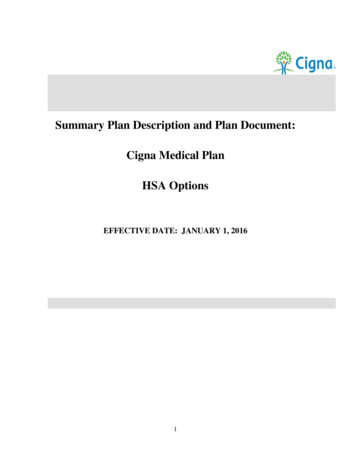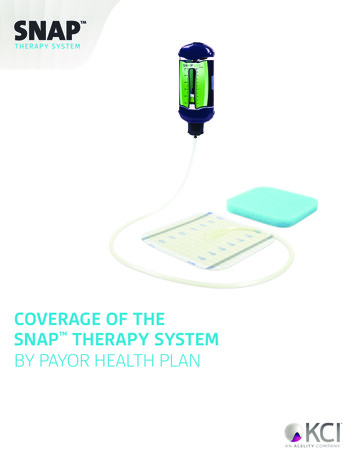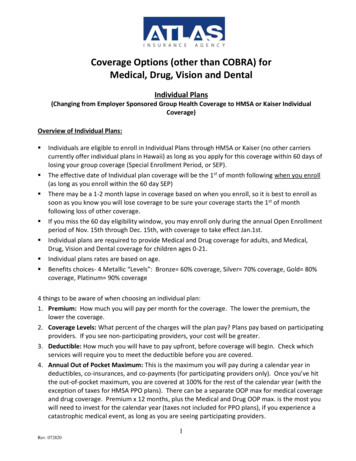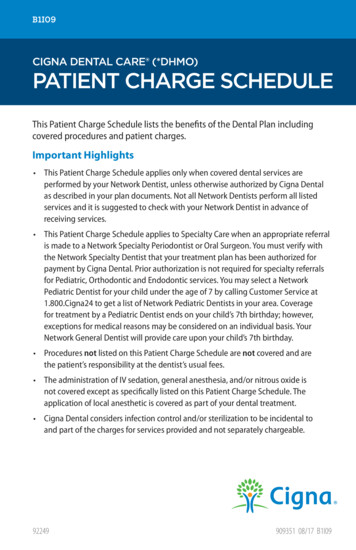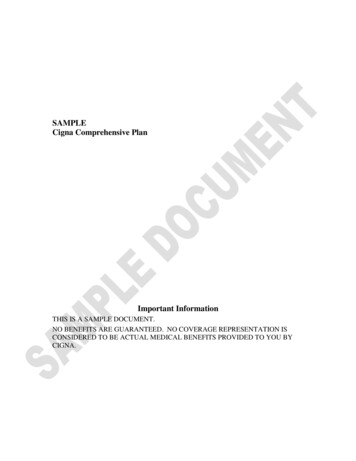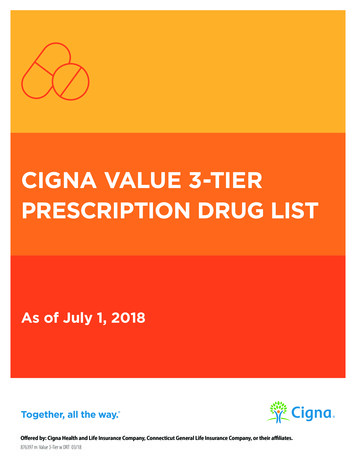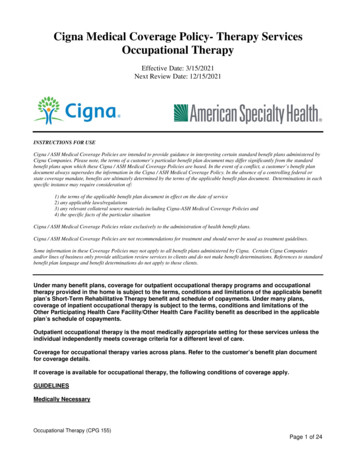
Transcription
Cigna Medical Coverage Policy- Therapy ServicesOccupational TherapyEffective Date: 3/15/2021Next Review Date: 12/15/2021INSTRUCTIONS FOR USECigna / ASH Medical Coverage Policies are intended to provide guidance in interpreting certain standard benefit plans administered byCigna Companies. Please note, the terms of a customer’s particular benefit plan document may differ significantly from the standardbenefit plans upon which these Cigna / ASH Medical Coverage Policies are based. In the event of a conflict, a customer’s benefit plandocument always supersedes the information in the Cigna / ASH Medical Coverage Policy. In the absence of a controlling federal orstate coverage mandate, benefits are ultimately determined by the terms of the applicable benefit plan document. Determinations in eachspecific instance may require consideration of:1) the terms of the applicable benefit plan document in effect on the date of service2) any applicable laws/regulations3) any relevant collateral source materials including Cigna-ASH Medical Coverage Policies and4) the specific facts of the particular situationCigna / ASH Medical Coverage Policies relate exclusively to the administration of health benefit plans.Cigna / ASH Medical Coverage Policies are not recommendations for treatment and should never be used as treatment guidelines.Some information in these Coverage Policies may not apply to all benefit plans administered by Cigna. Certain Cigna Companiesand/or lines of business only provide utilization review services to clients and do not make benefit determinations. References to standardbenefit plan language and benefit determinations do not apply to those clients.Under many benefit plans, coverage for outpatient occupational therapy programs and occupationaltherapy provided in the home is subject to the terms, conditions and limitations of the applicable benefitplan’s Short-Term Rehabilitative Therapy benefit and schedule of copayments. Under many plans,coverage of inpatient occupational therapy is subject to the terms, conditions and limitations of theOther Participating Health Care Facility/Other Health Care Facility benefit as described in the applicableplan’s schedule of copayments.Outpatient occupational therapy is the most medically appropriate setting for these services unless theindividual independently meets coverage criteria for a different level of care.Coverage for occupational therapy varies across plans. Refer to the customer’s benefit plan documentfor coverage details.If coverage is available for occupational therapy, the following conditions of coverage apply.GUIDELINESMedically NecessaryOccupational Therapy (CPG 155)Page 1 of 24
I.An occupational therapy evaluation is considered medically necessary for the assessment of aphysical impairment.II. Occupational therapy services are considered medically necessary to improve, adapt or restorefunctions which have been impaired or permanently lost and/or to reduce pain as a result ofillness, injury, loss of a body part, or congenital abnormality when ALL the following criteria aremet: The individual’s condition has the potential to improve or is improving in response to therapy,maximum improvement is yet to be attained; and there is an expectation that the anticipatedimprovement is attainable in a reasonable and generally predictable period of time.The program is individualized, and there is documentation outlining quantifiable, attainabletreatment goals.Improvement is evidenced by successive objective measurements.The services are delivered by a qualified provider of occupational therapy services (i.e.appropriately trained and licensed by the state to perform occupational therapy services).Occupational therapy occurs when the judgment, knowledge, and skills of a qualified provider ofoccupational therapy services (as defined by the scope of practice for therapists in each state)are necessary to safely and effectively furnish a recognized therapy service due to thecomplexity and sophistication of the plan of care and the medical condition of the individual, withthe goal of improvement of an impairment or functional limitation.Not Medically NecessaryI.OT services are considered not medically necessary if any of the following is determined: The individual’s condition does not have the potential to improve or is not improving in responseto therapy; or would be insignificant relative to the extent and duration of therapy required; andthere is an expectation that further improvement is NOT attainable.Improvement or restoration of function could reasonably be expected as the individual graduallyresumes normal activities without the provision of skilled therapy services. For example: An individual suffers a transient and easily reversible loss or reduction in function whichcould reasonably be expected to improve spontaneously as the patient graduallyresumes normal activities; A fully functional individual who develops temporary weakness from a brief period ofbed rest following abdominal surgery.Therapy services that do not require the skills of a qualified provider of OT services. Examplesinclude but not limited to: Activities for the general good and welfare of patients General exercises (basic aerobic, strength, flexibility or aquatic programs) topromote overall fitness/conditioning Services/programs for the primary purpose of enhancing athletic or recreationalsports. Massages and whirlpools for relaxation General public education/instruction sessions Repetitive gait or other activities and services that an individual can practiceindependently and can be self-administered safely and effectively. Activities that require only routine supervision and NOT the skilled services of aoccupational therapy provider When a home exercise program is sufficient and can be utilized to continuetherapy (examples of exceptions include but would not be limited to thefollowing: if patient has poor exercise technique that requires cueing andfeedback, lack of support at home if necessary for exercise programOccupational Therapy (CPG 155)Page 2 of 24
II.The following treatments are considered not medically necessary because they arenonmedical, educational or training in nature. In addition, these treatments/programs arespecifically excluded under many benefit plans: III.completion, and/or cognitive impairment that doesn’t allow the patient tocomplete the exercise program)Documentation fails to objectively verify subjective, objective and functional progress over areasonable and predictable period of time.The physical modalities are not preparatory to other skilled treatment procedures.Modalities that have been deemed to provide minimal to no clinical value independently orwithin a comprehensive treatment for any condition and/or not considered the current standardof care within a treatment program Infrared light therapy Vasopneumatic deviceTreatments are not supported in peer-reviewed literature.driving safety/driver trainingback schoolvocational rehabilitation programs and any programs with the primary goal of returning anindividual to workwork hardening programsDuplicative or redundant services expected to achieve the same therapeutic goal areconsidered not medically necessary. For example: Multiple modalities procedures that have similar or overlapping physiologic effects (e.g., multipleforms of superficial or deep heating modalities)Same or similar rehabilitative services provided as part of an authorized therapy programthrough another therapy discipline. When an individual receives physical, occupational, or speech therapy, the therapistsshould provide different treatments that reflect each therapy discipline's uniqueperspective on the individual's impairments and functional deficits and not duplicate thesame treatment. They must also have separate evaluations, treatment plans, and goals.When an individual receives manual therapy services from a physical therapist andchiropractic or osteopathic manipulation, the services must be documented as separateand distinct, performed on different body parts, and must be justified and nonduplicative.Experimental, Investigational, UnprovenI.Use of the following treatments is considered experimental, investigational or unproven: Intensive Model of constraint-induced movement therapy (CIMT)Intensive Model of Therapy (IMOT) programsDry hydrotherapy/aquamassage/hydromassageNon-invasive Interactive Neurostimulation (e.g., InterX )Microcurrent Electrical Nerve Stimulation (MENS)H-WAVE Equestrian therapy (e.g., hippotherapy)MEDEK TherapyThe Interactive Metronome ProgramDry needlingElastic therapeutic tape/taping (e.g., Kinesio tape, KT TAPE/KT TAPE PRO , Spidertech tape)Low-level laser therapy (LLLT)Occupational Therapy (CPG 155)Page 3 of 24
Occupational therapy (OT) services are skilled services which may be delivered by an occupational therapist orother health care professional acting within the scope of a professional license. A service is not considered askilled therapy service merely because it is furnished by a therapist or by a therapist/therapy assistant under thedirect or general supervision, as applicable, of a therapist. If a service can be self-administered or safely andeffectively furnished by an unskilled person, without the direct or general supervision, as applicable, of a therapist,the service cannot be regarded as a skilled therapy service even though a therapist actually furnishes the service.Similarly, the unavailability of a competent person to provide a non-skilled service, notwithstanding the importanceof the service to the patient, does not make it a skilled service when a therapist furnishes the service. Servicesthat do not require the professional skills of a therapist to perform or supervise are not medically necessary, evenif they are performed or supervised by a therapist, physician or NPP. Therefore, if a patient’s therapy can proceedsafely and effectively through a home exercise program, self-management program, restorative nursing programor caregiver assisted program, occupational therapy services are not indicated or medically necessary.Rehabilitative services are intended to improve, adapt or restore functions which have been impaired orpermanently lost as a result of illness, injury, loss of a body part, or congenital abnormality involving goals anindividual can reach in a reasonable period of time. If no improvement is documented after two weeks of treatment,an alternative treatment plan should be attempted. If no significant improvement is documented after a total offour weeks, re-evaluation by the referring provider may be indicated. Treatment is no longer medically necessarywhen the individual stops progressing toward those established goals. Treatment is no longer medically necessarywhen the individual stops progressing toward established goals.GENERAL BACKGROUNDAccording to the American Occupational Therapy Association, occupational therapists and occupational therapyassistants help people across their lifespan participate in the things they want and need to do through thetherapeutic use of everyday activities (occupations). Occupational therapists provide services to patients whohave impairments, functional limitations, disabilities, or changes in physical function and health status resultingfrom injury, disease, or other causes. OT addresses physical, cognitive, psychosocial, sensory, communication,and other areas of performance in various contexts and environments in everyday life activities that affect health,well-being, and quality of life. The overarching goal of occupational therapy is “to support [people’s] health andparticipation in life through engagement in occupations.” Medically necessary occupational therapy services mustrelate to a written treatment plan of care and be of a level of complexity that requires the judgment, knowledgeand skills of an occupational therapist to perform and/or supervise the services. The plan of care for medicallynecessary occupational therapy services is established by a licensed occupational therapist. The amount,frequency and duration of the occupational therapy services must be reasonable (within regional norms andcommonly accepted practice patterns); the services must be considered appropriate and needed for the treatmentof the condition and must not be palliative in nature. Thus, once therapeutic benefit has been achieved, or a homeexercise program could be used for further gains without the need for skilled occupational therapy, continuingsupervised occupational therapy is not considered medically necessary.OCCUPATIONAL THERAPY TREATMENT SESSIONSAn occupational therapy intervention is the purposeful interaction of the occupational therapist with the patientand, when appropriate, with other individuals involved in patient care, using various occupational therapyprocedures and techniques to produce changes in the condition that are consistent with the diagnosis andprognosis. Occupational therapy interventions consist of coordination, communication, and documentation;patient-related and family/caregiver instruction; and procedural interventions. Occupational therapists aim toalleviate impairment and functional limitation by designing, implementing, and modifying therapeutic interventions.An occupational therapy session can vary from fifteen minutes to four hours per day; however, treatment sessionslasting more than one hour per day are infrequent in outpatient settings. Treatment sessions for more than onehour per day may be medically appropriate for inpatient acute settings, day treatment programs, and selectoutpatient situations, but must be supported in the plan of care and based on a patient's medical condition. Anoccupational therapy session may include: Evaluation or reevaluation; Therapeutic use of everyday life and other purposeful activities, and other interventions focusing onpreparing patients for daily activities performed in life and work;Occupational Therapy (CPG 155)Page 4 of 24
Basic and advanced functional training in daily living, self-care and home management including activitiesof daily living (ADL) and instrumental activities of daily living (IADL);Management of feeding, eating and swallowing to improve eating and feeding performance;Cognitive, perceptual, safety and judgment evaluation and training;Adaptive training in and modification of activities, processes and environments (home, work, school, orcommunity), including ergonomic applications and performance improvement;Assessment, design, fabrication, application, fitting, and training in assistive technology, adaptive devices,and orthotic devices;Training in the use of prosthetic devices;Higher level independent living skill instruction and community/work functional reintegration;Functionally oriented upper extremity interventions;Training of the patient, caregivers, and family/parents in home exercise and activity programs;Skilled reassessment of the individual's problems, plan, and goals as part of the treatment session.MODALITIES AND PROCEDURESIn some states, occupational therapists are required to hold a specific certification to use modalities in practice.The American Medical Association (AMA) Current Procedural Terminology (CPT) manual defines a modality as"any physical agent applied to produce therapeutic changes to biologic tissue; includes but is not limited to thermal,acoustic, light, mechanical, or electric energy” (AMA, 2018). Modalities may be supervised, which means that theapplication of the modality doesn’t require direct one-on-one patient contact by the practitioner. Or modalities mayinvolve constant attendance, which indicates that the modality requires direct one-on-one patient contact by thepractitioner.Examples of supervised modalities include application of: Hot or cold packs, Mechanical traction, Unattended electrical stimulation, Vasopneumatic devices, Whirlpool, Paraffin bath, Diathermy, andExamples of modalities that require constant attendance include: Contrast baths, Ultrasound, Electrical stimulation, and Iontophoresis.Passive modalities are most effective during the acute phase of treatment, since they are typically directed atreducing pain, inflammation, and swelling. They may also be utilized during the acute phase of the exacerbationof a chronic condition. Passive modalities are rarely beneficial alone and are most effective when performed aspart of a comprehensive treatment approach. Some improvement with the use of passive modalities should beseen within three visits. If passive therapy is not contributing to improvement, passive therapy should bediscontinued and other evidence supported interventions implemented. After one or two weeks, the clinicaleffectiveness of passive modalities begins to decline significantly. In some situations, passive modalities may beindicated for up to one or two months as part of comprehensive occupational therapy program. The need forpassive modalities beyond two weeks should be objectively documented in the clinical record.The AMA CPT manual defines therapeutic procedures as "A manner of effecting change through the applicationof clinical skills and/or services that attempt to improve function" (AMA, 2018). Examples of therapeutic proceduresinclude therapeutic exercise to develop strength and endurance, range of motion and flexibility; neuromuscularre-education of movement, balance, coordination, kinesthetic sense, posture, and/or proprioceptive activities,aquatic therapy, and manual therapy techniques (e.g., mobilization/manipulation, manual lymphatic drainage,manual traction); or therapeutic activities using dynamic activities to improve functional performance (direct oneon-one patient contact by the practitioner).Occupational Therapy (CPG 155)Page 5 of 24
Transition from passive physiotherapy modalities to active treatment procedures should be timely and evidencedin the medical record, including instructions on self/home care. And in most cases, active treatment should beinitiated in addition to modality use at a level that is appropriate for the patient.Active therapeutic procedures are typically started as swelling, pain, and inflammation are reduced. The need forstabilization and support is replaced by the need for increased range of motion and restoration of function. Activecare elements include increasing range of motion, strengthening primary and secondary stabilizers of a givenregion, and increasing the endurance capability of the muscles. Care focuses on active participation of the patientin their exercise program. Activities of Daily Living (ADLs) training, muscle strengthening, movement retraining,and progressive resistive exercises are considered active procedures. In general, patients should progress fromactive procedures to a home exercise program.Below is a description and medical necessity criteria, as applicable, for different treatment interventions, includingspecific modalities and therapeutic procedures associated with occupational therapy. This material is forinformational purposes only and is not indicative of coverage, nor is it an exhaustive list of services provided.Hydrotherapy/Whirlpool/Hubbard TankThese modalities involve supervised use of agitated water in order to relieve muscle spasm, improve circulation,or cleanse wounds e.g., ulcers, skin conditions. More specifically, Hubbard tank involves a full-body immersiontank for treating severely burned, debilitated and/or neurologically impaired individuals. Hydrotherapy isconsidered medically necessary for pain relief, muscle relaxation and improvement of movement for persons withmusculoskeletal conditions. It is also considered medically necessary for wound care (cleansing anddebridement). It is not appropriate to utilize more than one hydrotherapy modality on the same day.Fluidotherapy This modality is used specifically for acute and subacute conditions of the extre
Other Participating Health Care Facility/Other Health Care Facility benefit as described in the applicable plan’s schedule of copayments. Outpatient occupational therapy is the most medically appropriate setting for these services unless the individual independent
